University of Sunderland Financial Management Assignment Solution
VerifiedAdded on 2023/01/16
|20
|3760
|62
Homework Assignment
AI Summary
This document presents a comprehensive solution to a financial management assignment, addressing key concepts such as equity finance and investment appraisal techniques. The assignment delves into the issue of right shares, including calculations for the number of shares to be issued, theoretical ex-rights price, and anticipated earnings per share. It evaluates the importance of scrip dividends for both shareholders and companies, outlining their benefits and drawbacks. Furthermore, the solution explores various investment appraisal techniques like payback period, accounting rate of return, net present value (NPV), and internal rate of return (IRR), providing detailed calculations and recommendations for a specific business scenario involving the acquisition of new machinery. The document aims to provide a clear and concise understanding of the topics with detailed workings.
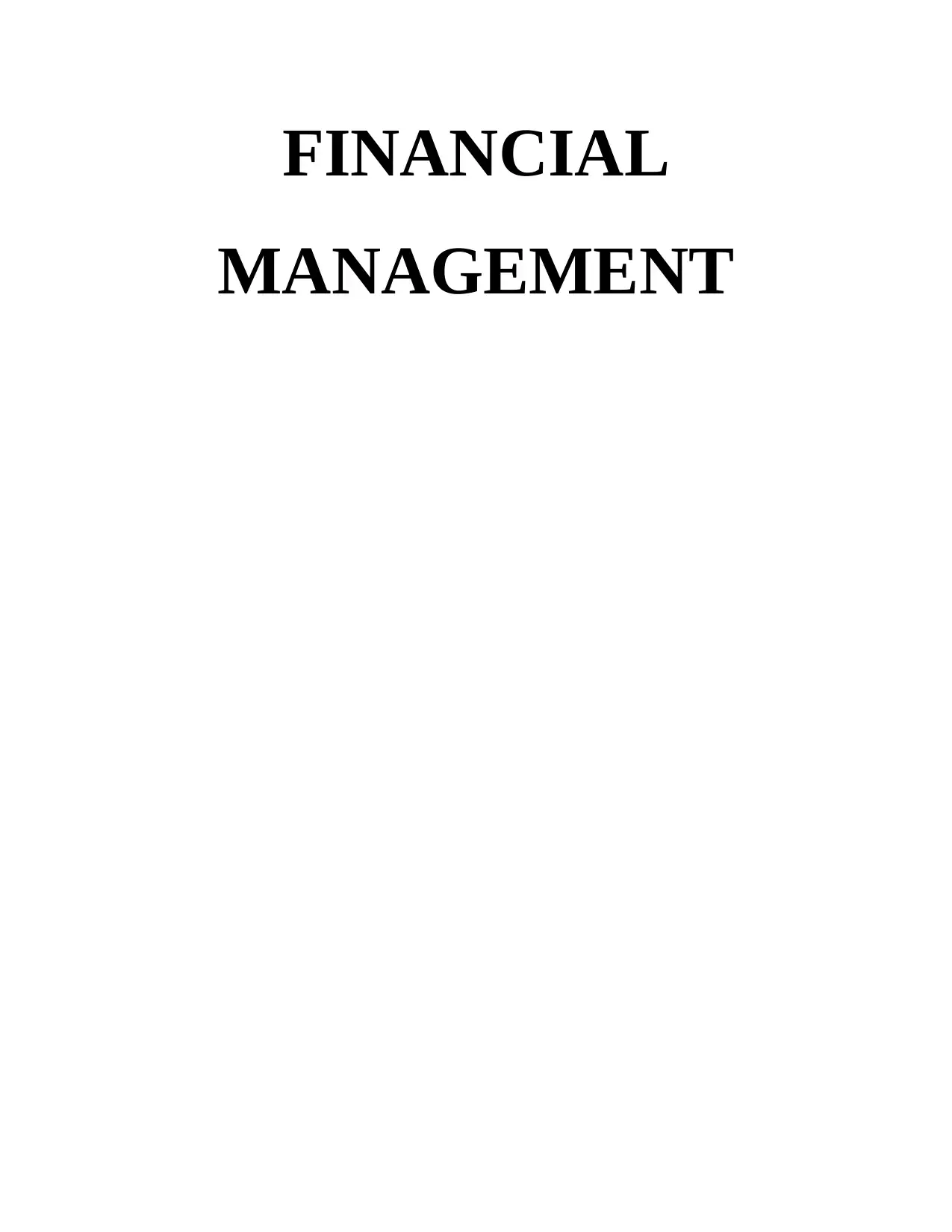
FINANCIAL
MANAGEMENT
MANAGEMENT
Paraphrase This Document
Need a fresh take? Get an instant paraphrase of this document with our AI Paraphraser
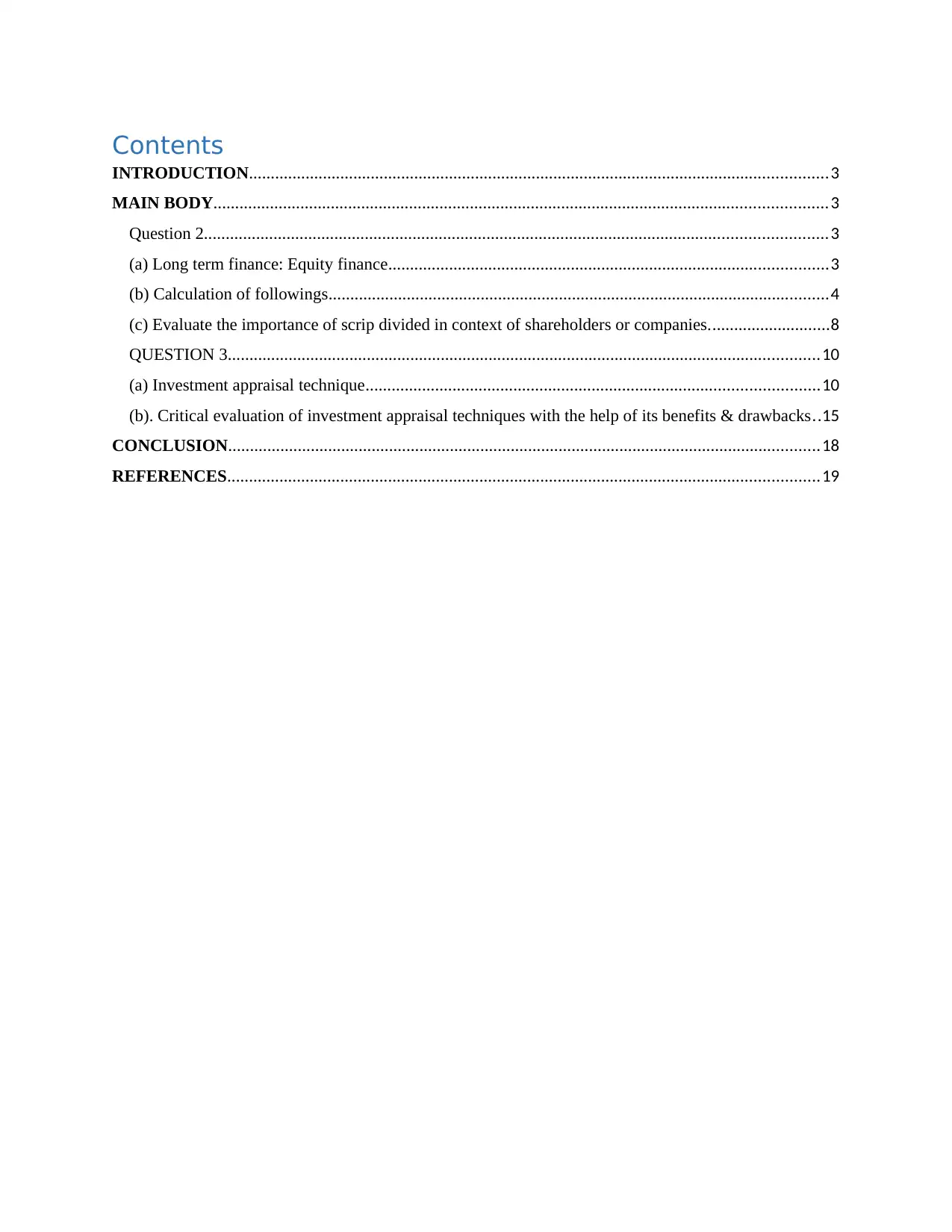
Contents
INTRODUCTION.....................................................................................................................................3
MAIN BODY.............................................................................................................................................3
Question 2...............................................................................................................................................3
(a) Long term finance: Equity finance.....................................................................................................3
(b) Calculation of followings...................................................................................................................4
(c) Evaluate the importance of scrip divided in context of shareholders or companies............................8
QUESTION 3........................................................................................................................................10
(a) Investment appraisal technique........................................................................................................10
(b). Critical evaluation of investment appraisal techniques with the help of its benefits & drawbacks..15
CONCLUSION........................................................................................................................................18
REFERENCES........................................................................................................................................19
INTRODUCTION.....................................................................................................................................3
MAIN BODY.............................................................................................................................................3
Question 2...............................................................................................................................................3
(a) Long term finance: Equity finance.....................................................................................................3
(b) Calculation of followings...................................................................................................................4
(c) Evaluate the importance of scrip divided in context of shareholders or companies............................8
QUESTION 3........................................................................................................................................10
(a) Investment appraisal technique........................................................................................................10
(b). Critical evaluation of investment appraisal techniques with the help of its benefits & drawbacks..15
CONCLUSION........................................................................................................................................18
REFERENCES........................................................................................................................................19
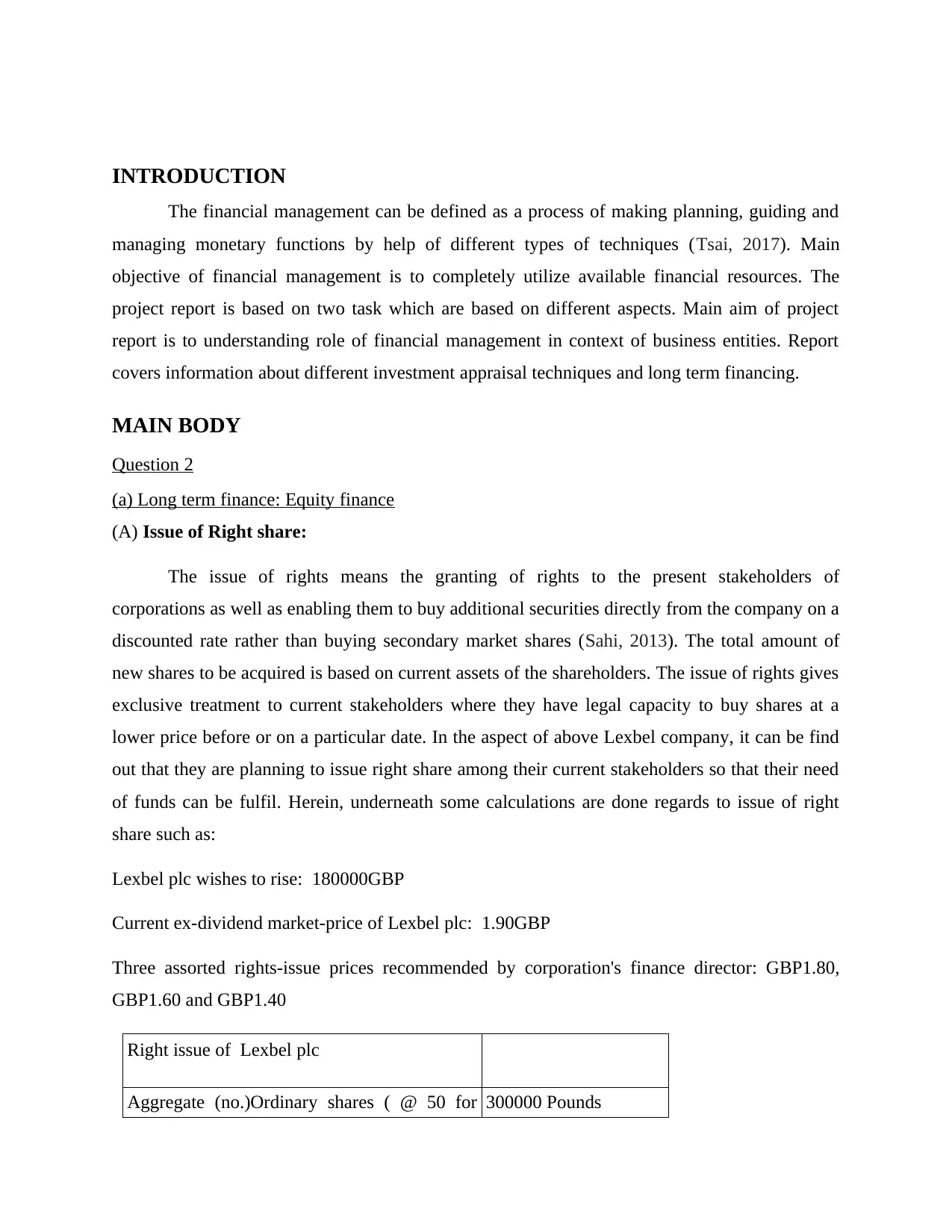
INTRODUCTION
The financial management can be defined as a process of making planning, guiding and
managing monetary functions by help of different types of techniques (Tsai, 2017). Main
objective of financial management is to completely utilize available financial resources. The
project report is based on two task which are based on different aspects. Main aim of project
report is to understanding role of financial management in context of business entities. Report
covers information about different investment appraisal techniques and long term financing.
MAIN BODY
Question 2
(a) Long term finance: Equity finance
(A) Issue of Right share:
The issue of rights means the granting of rights to the present stakeholders of
corporations as well as enabling them to buy additional securities directly from the company on a
discounted rate rather than buying secondary market shares (Sahi, 2013). The total amount of
new shares to be acquired is based on current assets of the shareholders. The issue of rights gives
exclusive treatment to current stakeholders where they have legal capacity to buy shares at a
lower price before or on a particular date. In the aspect of above Lexbel company, it can be find
out that they are planning to issue right share among their current stakeholders so that their need
of funds can be fulfil. Herein, underneath some calculations are done regards to issue of right
share such as:
Lexbel plc wishes to rise: 180000GBP
Current ex-dividend market-price of Lexbel plc: 1.90GBP
Three assorted rights-issue prices recommended by corporation's finance director: GBP1.80,
GBP1.60 and GBP1.40
Right issue of Lexbel plc
Aggregate (no.)Ordinary shares ( @ 50 for 300000 Pounds
The financial management can be defined as a process of making planning, guiding and
managing monetary functions by help of different types of techniques (Tsai, 2017). Main
objective of financial management is to completely utilize available financial resources. The
project report is based on two task which are based on different aspects. Main aim of project
report is to understanding role of financial management in context of business entities. Report
covers information about different investment appraisal techniques and long term financing.
MAIN BODY
Question 2
(a) Long term finance: Equity finance
(A) Issue of Right share:
The issue of rights means the granting of rights to the present stakeholders of
corporations as well as enabling them to buy additional securities directly from the company on a
discounted rate rather than buying secondary market shares (Sahi, 2013). The total amount of
new shares to be acquired is based on current assets of the shareholders. The issue of rights gives
exclusive treatment to current stakeholders where they have legal capacity to buy shares at a
lower price before or on a particular date. In the aspect of above Lexbel company, it can be find
out that they are planning to issue right share among their current stakeholders so that their need
of funds can be fulfil. Herein, underneath some calculations are done regards to issue of right
share such as:
Lexbel plc wishes to rise: 180000GBP
Current ex-dividend market-price of Lexbel plc: 1.90GBP
Three assorted rights-issue prices recommended by corporation's finance director: GBP1.80,
GBP1.60 and GBP1.40
Right issue of Lexbel plc
Aggregate (no.)Ordinary shares ( @ 50 for 300000 Pounds
⊘ This is a preview!⊘
Do you want full access?
Subscribe today to unlock all pages.

Trusted by 1+ million students worldwide
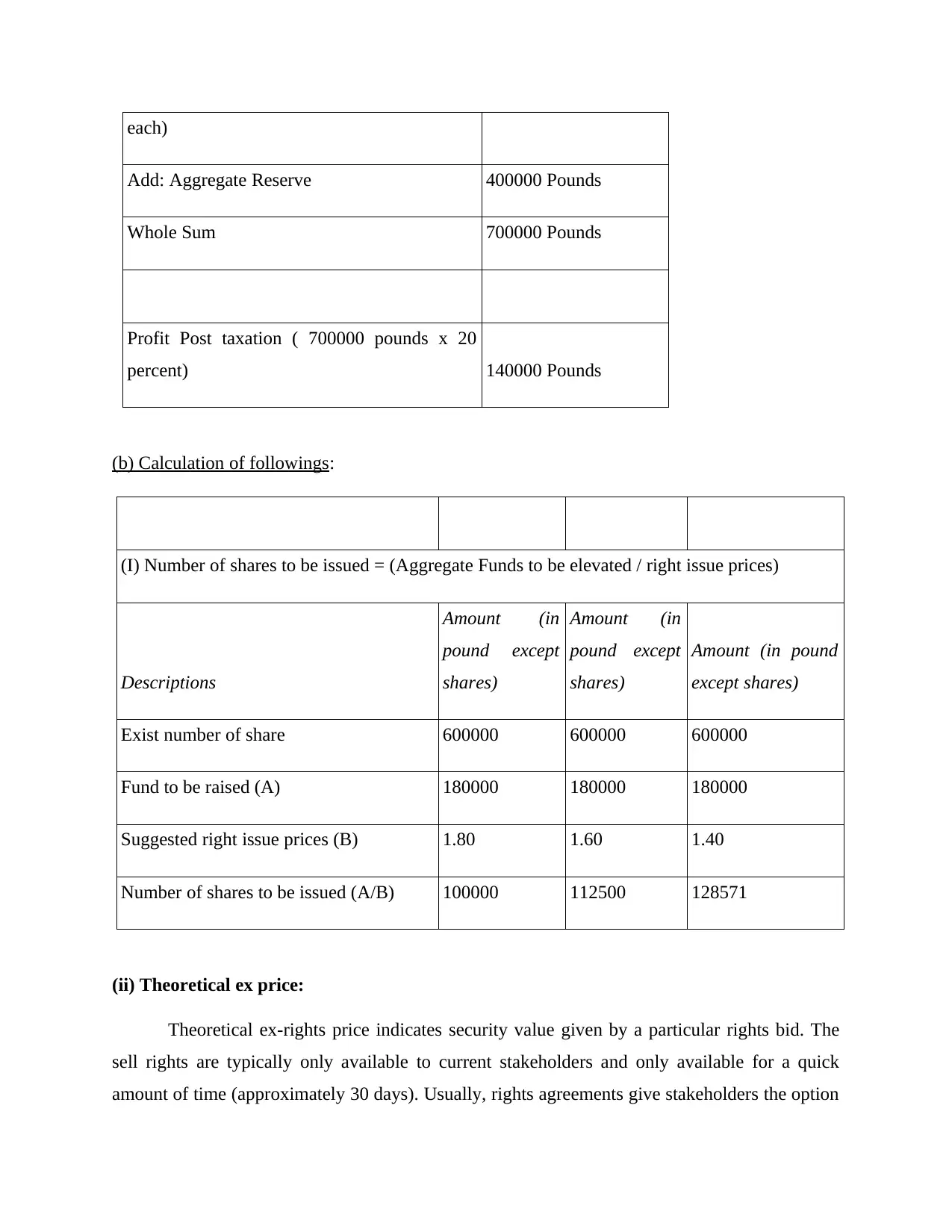
each)
Add: Aggregate Reserve 400000 Pounds
Whole Sum 700000 Pounds
Profit Post taxation ( 700000 pounds x 20
percent) 140000 Pounds
(b) Calculation of followings:
(I) Number of shares to be issued = (Aggregate Funds to be elevated / right issue prices)
Descriptions
Amount (in
pound except
shares)
Amount (in
pound except
shares)
Amount (in pound
except shares)
Exist number of share 600000 600000 600000
Fund to be raised (A) 180000 180000 180000
Suggested right issue prices (B) 1.80 1.60 1.40
Number of shares to be issued (A/B) 100000 112500 128571
(ii) Theoretical ex price:
Theoretical ex-rights price indicates security value given by a particular rights bid. The
sell rights are typically only available to current stakeholders and only available for a quick
amount of time (approximately 30 days). Usually, rights agreements give stakeholders the option
Add: Aggregate Reserve 400000 Pounds
Whole Sum 700000 Pounds
Profit Post taxation ( 700000 pounds x 20
percent) 140000 Pounds
(b) Calculation of followings:
(I) Number of shares to be issued = (Aggregate Funds to be elevated / right issue prices)
Descriptions
Amount (in
pound except
shares)
Amount (in
pound except
shares)
Amount (in pound
except shares)
Exist number of share 600000 600000 600000
Fund to be raised (A) 180000 180000 180000
Suggested right issue prices (B) 1.80 1.60 1.40
Number of shares to be issued (A/B) 100000 112500 128571
(ii) Theoretical ex price:
Theoretical ex-rights price indicates security value given by a particular rights bid. The
sell rights are typically only available to current stakeholders and only available for a quick
amount of time (approximately 30 days). Usually, rights agreements give stakeholders the option
Paraphrase This Document
Need a fresh take? Get an instant paraphrase of this document with our AI Paraphraser
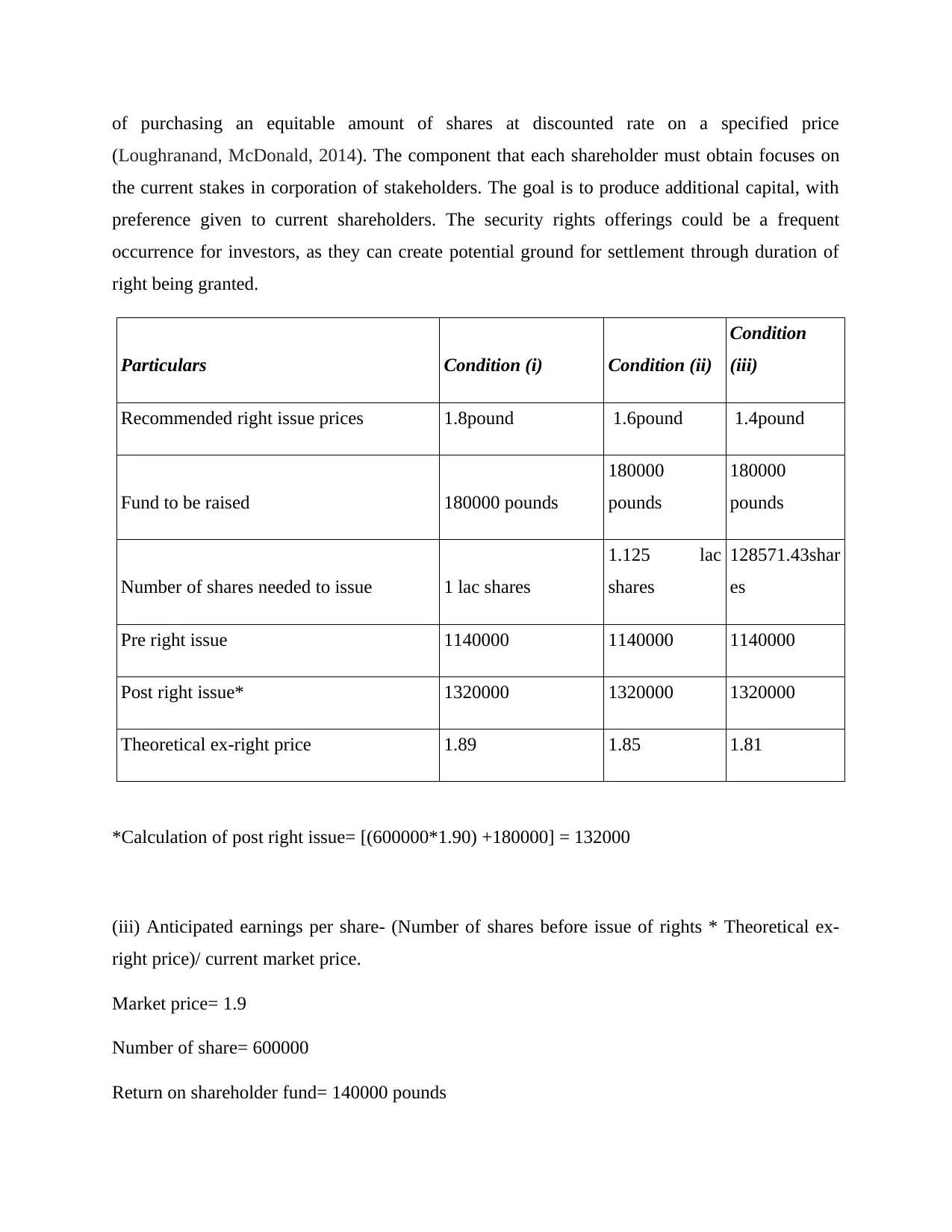
of purchasing an equitable amount of shares at discounted rate on a specified price
(Loughranand, McDonald, 2014). The component that each shareholder must obtain focuses on
the current stakes in corporation of stakeholders. The goal is to produce additional capital, with
preference given to current shareholders. The security rights offerings could be a frequent
occurrence for investors, as they can create potential ground for settlement through duration of
right being granted.
Particulars Condition (i) Condition (ii)
Condition
(iii)
Recommended right issue prices 1.8pound 1.6pound 1.4pound
Fund to be raised 180000 pounds
180000
pounds
180000
pounds
Number of shares needed to issue 1 lac shares
1.125 lac
shares
128571.43shar
es
Pre right issue 1140000 1140000 1140000
Post right issue* 1320000 1320000 1320000
Theoretical ex-right price 1.89 1.85 1.81
*Calculation of post right issue= [(600000*1.90) +180000] = 132000
(iii) Anticipated earnings per share- (Number of shares before issue of rights * Theoretical ex-
right price)/ current market price.
Market price= 1.9
Number of share= 600000
Return on shareholder fund= 140000 pounds
(Loughranand, McDonald, 2014). The component that each shareholder must obtain focuses on
the current stakes in corporation of stakeholders. The goal is to produce additional capital, with
preference given to current shareholders. The security rights offerings could be a frequent
occurrence for investors, as they can create potential ground for settlement through duration of
right being granted.
Particulars Condition (i) Condition (ii)
Condition
(iii)
Recommended right issue prices 1.8pound 1.6pound 1.4pound
Fund to be raised 180000 pounds
180000
pounds
180000
pounds
Number of shares needed to issue 1 lac shares
1.125 lac
shares
128571.43shar
es
Pre right issue 1140000 1140000 1140000
Post right issue* 1320000 1320000 1320000
Theoretical ex-right price 1.89 1.85 1.81
*Calculation of post right issue= [(600000*1.90) +180000] = 132000
(iii) Anticipated earnings per share- (Number of shares before issue of rights * Theoretical ex-
right price)/ current market price.
Market price= 1.9
Number of share= 600000
Return on shareholder fund= 140000 pounds
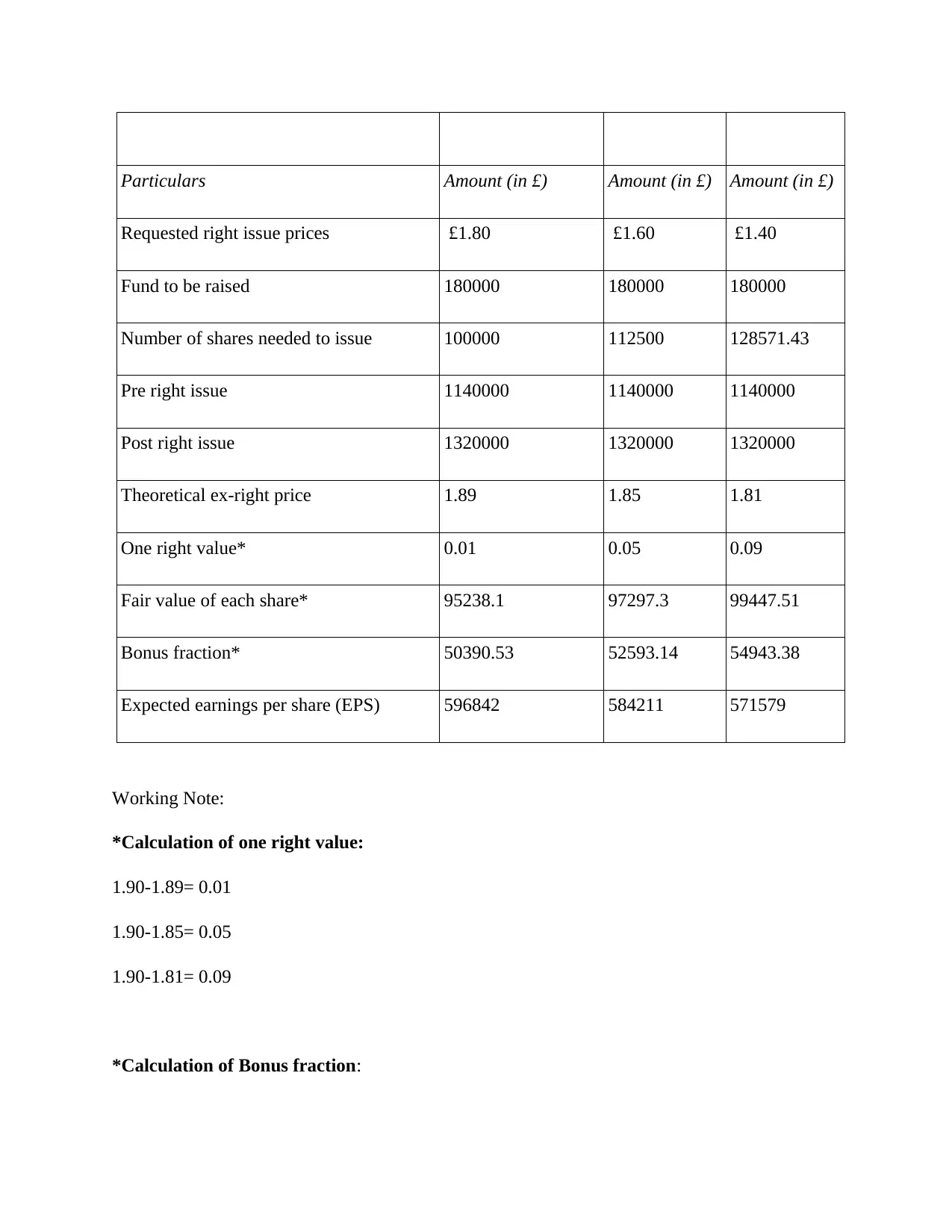
Particulars Amount (in £) Amount (in £) Amount (in £)
Requested right issue prices £1.80 £1.60 £1.40
Fund to be raised 180000 180000 180000
Number of shares needed to issue 100000 112500 128571.43
Pre right issue 1140000 1140000 1140000
Post right issue 1320000 1320000 1320000
Theoretical ex-right price 1.89 1.85 1.81
One right value* 0.01 0.05 0.09
Fair value of each share* 95238.1 97297.3 99447.51
Bonus fraction* 50390.53 52593.14 54943.38
Expected earnings per share (EPS) 596842 584211 571579
Working Note:
*Calculation of one right value:
1.90-1.89= 0.01
1.90-1.85= 0.05
1.90-1.81= 0.09
*Calculation of Bonus fraction:
Requested right issue prices £1.80 £1.60 £1.40
Fund to be raised 180000 180000 180000
Number of shares needed to issue 100000 112500 128571.43
Pre right issue 1140000 1140000 1140000
Post right issue 1320000 1320000 1320000
Theoretical ex-right price 1.89 1.85 1.81
One right value* 0.01 0.05 0.09
Fair value of each share* 95238.1 97297.3 99447.51
Bonus fraction* 50390.53 52593.14 54943.38
Expected earnings per share (EPS) 596842 584211 571579
Working Note:
*Calculation of one right value:
1.90-1.89= 0.01
1.90-1.85= 0.05
1.90-1.81= 0.09
*Calculation of Bonus fraction:
⊘ This is a preview!⊘
Do you want full access?
Subscribe today to unlock all pages.

Trusted by 1+ million students worldwide

95238.1/1.89= 50390.53
97297.3/1.85= 52593.14
99447.51/1.81= 54943.38
*Calculation of fair value of each share:
180000/1.89= 95238.1
180000/1.85= 97297.3
180000/1.81= 99447.51
*Calculation of EPS:
600000X1.89/1.90= 1134000/1.90= 596842
600000X1.85/1.90= 110000/1.90= 584211
600000X1.81/1.90= 1086000/1.90= 571579
(iv) Form of issue of right issue price:
Particulars Amount (in pounds)
Amount (in
pounds)
Amount (in
pounds)
Suggested right issue prices 1.80 1.60 1.40
Fund to be raised 180000 180000 180000
Number of shares to be issued (A) 100000 112500 128571.43
Exist number of share (B) 600000 600000 600000
Ratio of new share to existing one (B/A) 6 5.33 4.67
97297.3/1.85= 52593.14
99447.51/1.81= 54943.38
*Calculation of fair value of each share:
180000/1.89= 95238.1
180000/1.85= 97297.3
180000/1.81= 99447.51
*Calculation of EPS:
600000X1.89/1.90= 1134000/1.90= 596842
600000X1.85/1.90= 110000/1.90= 584211
600000X1.81/1.90= 1086000/1.90= 571579
(iv) Form of issue of right issue price:
Particulars Amount (in pounds)
Amount (in
pounds)
Amount (in
pounds)
Suggested right issue prices 1.80 1.60 1.40
Fund to be raised 180000 180000 180000
Number of shares to be issued (A) 100000 112500 128571.43
Exist number of share (B) 600000 600000 600000
Ratio of new share to existing one (B/A) 6 5.33 4.67
Paraphrase This Document
Need a fresh take? Get an instant paraphrase of this document with our AI Paraphraser
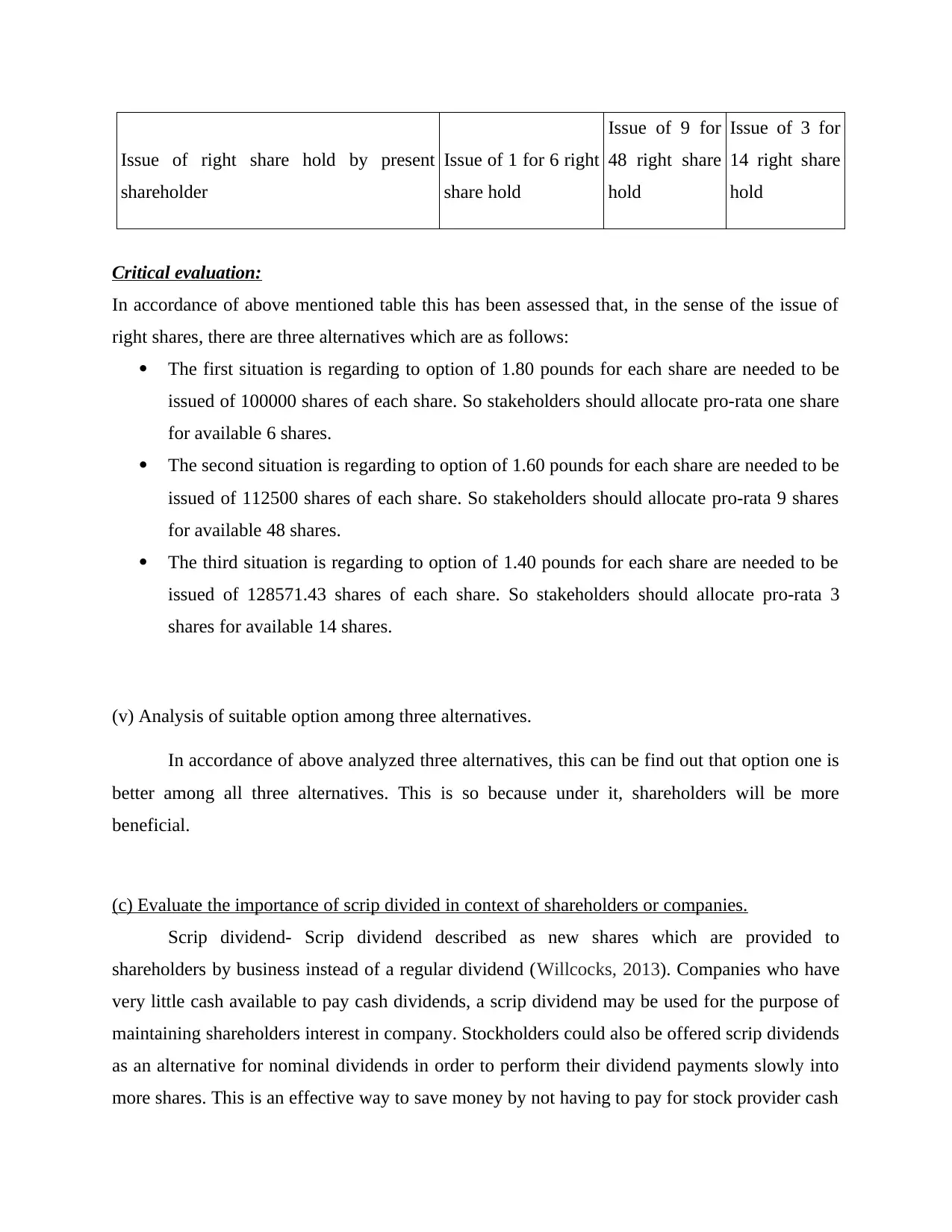
Issue of right share hold by present
shareholder
Issue of 1 for 6 right
share hold
Issue of 9 for
48 right share
hold
Issue of 3 for
14 right share
hold
Critical evaluation:
In accordance of above mentioned table this has been assessed that, in the sense of the issue of
right shares, there are three alternatives which are as follows:
The first situation is regarding to option of 1.80 pounds for each share are needed to be
issued of 100000 shares of each share. So stakeholders should allocate pro-rata one share
for available 6 shares.
The second situation is regarding to option of 1.60 pounds for each share are needed to be
issued of 112500 shares of each share. So stakeholders should allocate pro-rata 9 shares
for available 48 shares.
The third situation is regarding to option of 1.40 pounds for each share are needed to be
issued of 128571.43 shares of each share. So stakeholders should allocate pro-rata 3
shares for available 14 shares.
(v) Analysis of suitable option among three alternatives.
In accordance of above analyzed three alternatives, this can be find out that option one is
better among all three alternatives. This is so because under it, shareholders will be more
beneficial.
(c) Evaluate the importance of scrip divided in context of shareholders or companies.
Scrip dividend- Scrip dividend described as new shares which are provided to
shareholders by business instead of a regular dividend (Willcocks, 2013). Companies who have
very little cash available to pay cash dividends, a scrip dividend may be used for the purpose of
maintaining shareholders interest in company. Stockholders could also be offered scrip dividends
as an alternative for nominal dividends in order to perform their dividend payments slowly into
more shares. This is an effective way to save money by not having to pay for stock provider cash
shareholder
Issue of 1 for 6 right
share hold
Issue of 9 for
48 right share
hold
Issue of 3 for
14 right share
hold
Critical evaluation:
In accordance of above mentioned table this has been assessed that, in the sense of the issue of
right shares, there are three alternatives which are as follows:
The first situation is regarding to option of 1.80 pounds for each share are needed to be
issued of 100000 shares of each share. So stakeholders should allocate pro-rata one share
for available 6 shares.
The second situation is regarding to option of 1.60 pounds for each share are needed to be
issued of 112500 shares of each share. So stakeholders should allocate pro-rata 9 shares
for available 48 shares.
The third situation is regarding to option of 1.40 pounds for each share are needed to be
issued of 128571.43 shares of each share. So stakeholders should allocate pro-rata 3
shares for available 14 shares.
(v) Analysis of suitable option among three alternatives.
In accordance of above analyzed three alternatives, this can be find out that option one is
better among all three alternatives. This is so because under it, shareholders will be more
beneficial.
(c) Evaluate the importance of scrip divided in context of shareholders or companies.
Scrip dividend- Scrip dividend described as new shares which are provided to
shareholders by business instead of a regular dividend (Willcocks, 2013). Companies who have
very little cash available to pay cash dividends, a scrip dividend may be used for the purpose of
maintaining shareholders interest in company. Stockholders could also be offered scrip dividends
as an alternative for nominal dividends in order to perform their dividend payments slowly into
more shares. This is an effective way to save money by not having to pay for stock provider cash
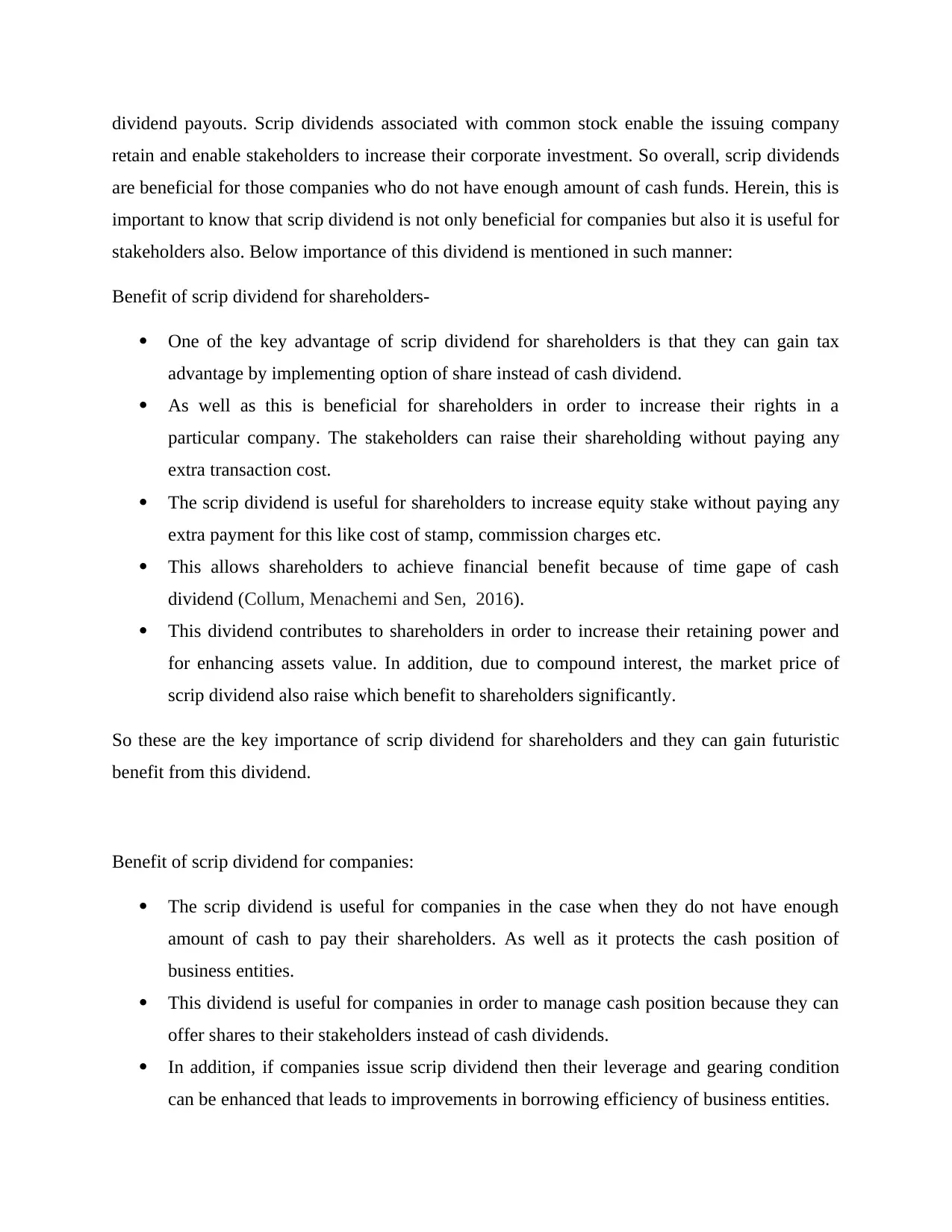
dividend payouts. Scrip dividends associated with common stock enable the issuing company
retain and enable stakeholders to increase their corporate investment. So overall, scrip dividends
are beneficial for those companies who do not have enough amount of cash funds. Herein, this is
important to know that scrip dividend is not only beneficial for companies but also it is useful for
stakeholders also. Below importance of this dividend is mentioned in such manner:
Benefit of scrip dividend for shareholders-
One of the key advantage of scrip dividend for shareholders is that they can gain tax
advantage by implementing option of share instead of cash dividend.
As well as this is beneficial for shareholders in order to increase their rights in a
particular company. The stakeholders can raise their shareholding without paying any
extra transaction cost.
The scrip dividend is useful for shareholders to increase equity stake without paying any
extra payment for this like cost of stamp, commission charges etc.
This allows shareholders to achieve financial benefit because of time gape of cash
dividend (Collum, Menachemi and Sen, 2016).
This dividend contributes to shareholders in order to increase their retaining power and
for enhancing assets value. In addition, due to compound interest, the market price of
scrip dividend also raise which benefit to shareholders significantly.
So these are the key importance of scrip dividend for shareholders and they can gain futuristic
benefit from this dividend.
Benefit of scrip dividend for companies:
The scrip dividend is useful for companies in the case when they do not have enough
amount of cash to pay their shareholders. As well as it protects the cash position of
business entities.
This dividend is useful for companies in order to manage cash position because they can
offer shares to their stakeholders instead of cash dividends.
In addition, if companies issue scrip dividend then their leverage and gearing condition
can be enhanced that leads to improvements in borrowing efficiency of business entities.
retain and enable stakeholders to increase their corporate investment. So overall, scrip dividends
are beneficial for those companies who do not have enough amount of cash funds. Herein, this is
important to know that scrip dividend is not only beneficial for companies but also it is useful for
stakeholders also. Below importance of this dividend is mentioned in such manner:
Benefit of scrip dividend for shareholders-
One of the key advantage of scrip dividend for shareholders is that they can gain tax
advantage by implementing option of share instead of cash dividend.
As well as this is beneficial for shareholders in order to increase their rights in a
particular company. The stakeholders can raise their shareholding without paying any
extra transaction cost.
The scrip dividend is useful for shareholders to increase equity stake without paying any
extra payment for this like cost of stamp, commission charges etc.
This allows shareholders to achieve financial benefit because of time gape of cash
dividend (Collum, Menachemi and Sen, 2016).
This dividend contributes to shareholders in order to increase their retaining power and
for enhancing assets value. In addition, due to compound interest, the market price of
scrip dividend also raise which benefit to shareholders significantly.
So these are the key importance of scrip dividend for shareholders and they can gain futuristic
benefit from this dividend.
Benefit of scrip dividend for companies:
The scrip dividend is useful for companies in the case when they do not have enough
amount of cash to pay their shareholders. As well as it protects the cash position of
business entities.
This dividend is useful for companies in order to manage cash position because they can
offer shares to their stakeholders instead of cash dividends.
In addition, if companies issue scrip dividend then their leverage and gearing condition
can be enhanced that leads to improvements in borrowing efficiency of business entities.
⊘ This is a preview!⊘
Do you want full access?
Subscribe today to unlock all pages.

Trusted by 1+ million students worldwide
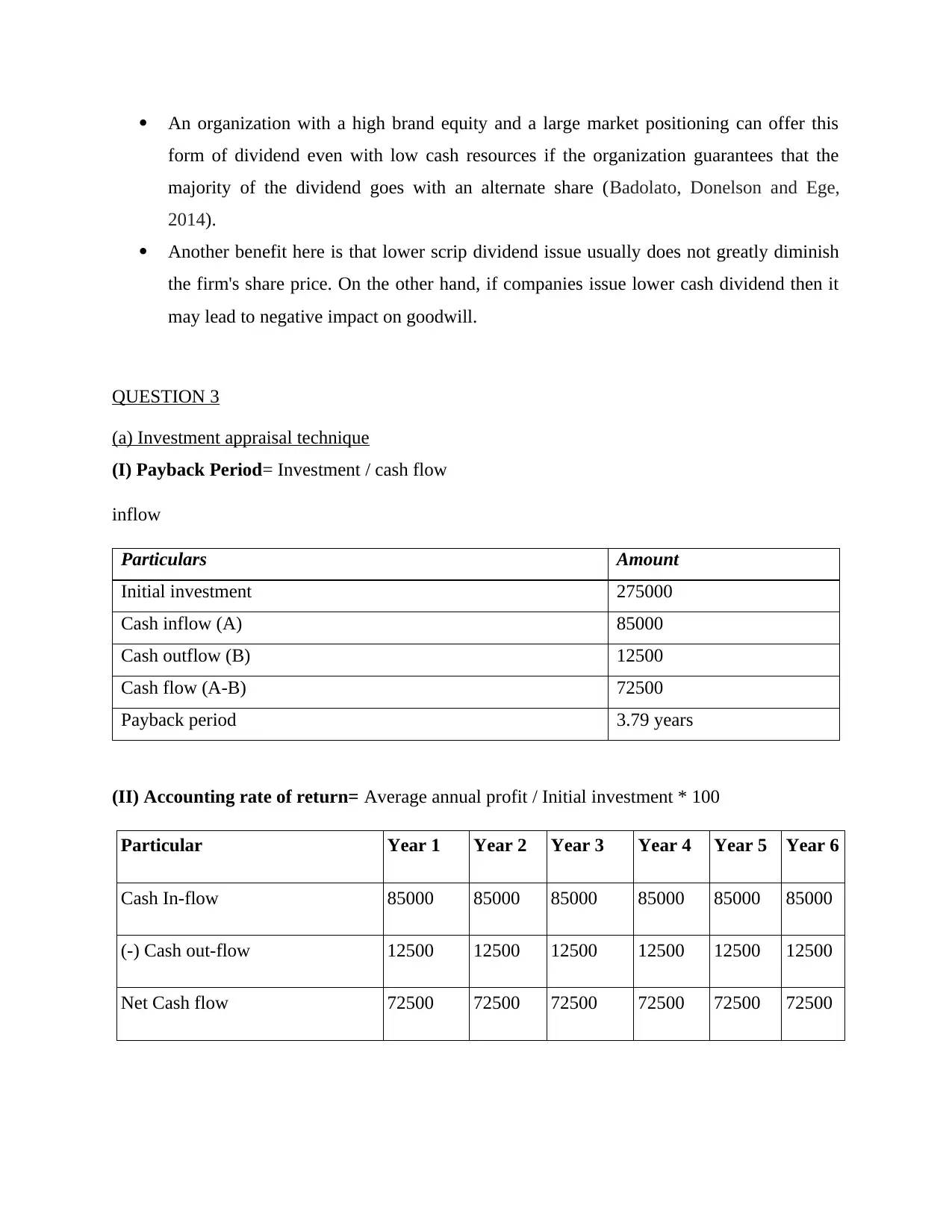
An organization with a high brand equity and a large market positioning can offer this
form of dividend even with low cash resources if the organization guarantees that the
majority of the dividend goes with an alternate share (Badolato, Donelson and Ege,
2014).
Another benefit here is that lower scrip dividend issue usually does not greatly diminish
the firm's share price. On the other hand, if companies issue lower cash dividend then it
may lead to negative impact on goodwill.
QUESTION 3
(a) Investment appraisal technique
(I) Payback Period= Investment / cash flow
inflow
Particulars Amount
Initial investment 275000
Cash inflow (A) 85000
Cash outflow (B) 12500
Cash flow (A-B) 72500
Payback period 3.79 years
(II) Accounting rate of return= Average annual profit / Initial investment * 100
Particular Year 1 Year 2 Year 3 Year 4 Year 5 Year 6
Cash In-flow 85000 85000 85000 85000 85000 85000
(-) Cash out-flow 12500 12500 12500 12500 12500 12500
Net Cash flow 72500 72500 72500 72500 72500 72500
form of dividend even with low cash resources if the organization guarantees that the
majority of the dividend goes with an alternate share (Badolato, Donelson and Ege,
2014).
Another benefit here is that lower scrip dividend issue usually does not greatly diminish
the firm's share price. On the other hand, if companies issue lower cash dividend then it
may lead to negative impact on goodwill.
QUESTION 3
(a) Investment appraisal technique
(I) Payback Period= Investment / cash flow
inflow
Particulars Amount
Initial investment 275000
Cash inflow (A) 85000
Cash outflow (B) 12500
Cash flow (A-B) 72500
Payback period 3.79 years
(II) Accounting rate of return= Average annual profit / Initial investment * 100
Particular Year 1 Year 2 Year 3 Year 4 Year 5 Year 6
Cash In-flow 85000 85000 85000 85000 85000 85000
(-) Cash out-flow 12500 12500 12500 12500 12500 12500
Net Cash flow 72500 72500 72500 72500 72500 72500
Paraphrase This Document
Need a fresh take? Get an instant paraphrase of this document with our AI Paraphraser
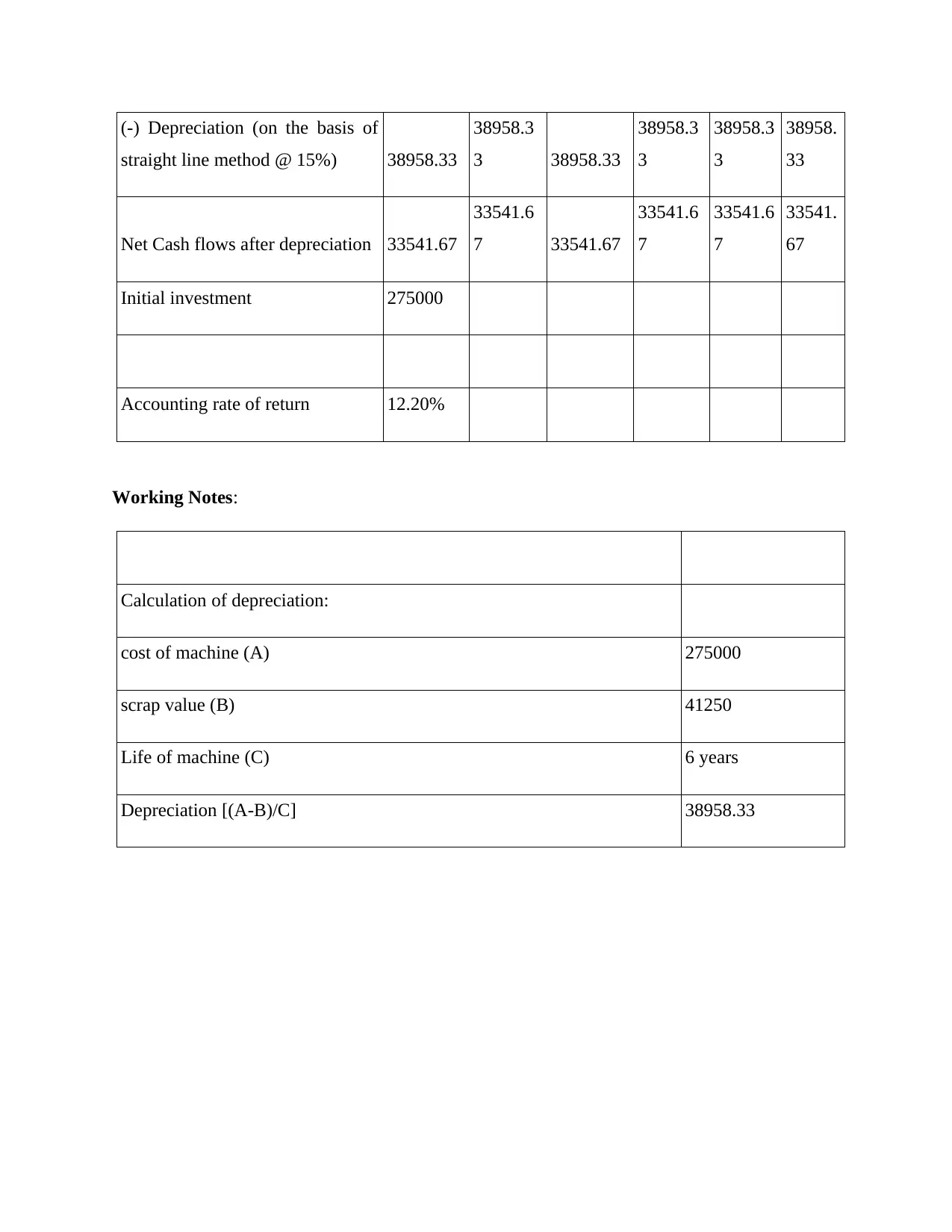
(-) Depreciation (on the basis of
straight line method @ 15%) 38958.33
38958.3
3 38958.33
38958.3
3
38958.3
3
38958.
33
Net Cash flows after depreciation 33541.67
33541.6
7 33541.67
33541.6
7
33541.6
7
33541.
67
Initial investment 275000
Accounting rate of return 12.20%
Working Notes:
Calculation of depreciation:
cost of machine (A) 275000
scrap value (B) 41250
Life of machine (C) 6 years
Depreciation [(A-B)/C] 38958.33
straight line method @ 15%) 38958.33
38958.3
3 38958.33
38958.3
3
38958.3
3
38958.
33
Net Cash flows after depreciation 33541.67
33541.6
7 33541.67
33541.6
7
33541.6
7
33541.
67
Initial investment 275000
Accounting rate of return 12.20%
Working Notes:
Calculation of depreciation:
cost of machine (A) 275000
scrap value (B) 41250
Life of machine (C) 6 years
Depreciation [(A-B)/C] 38958.33
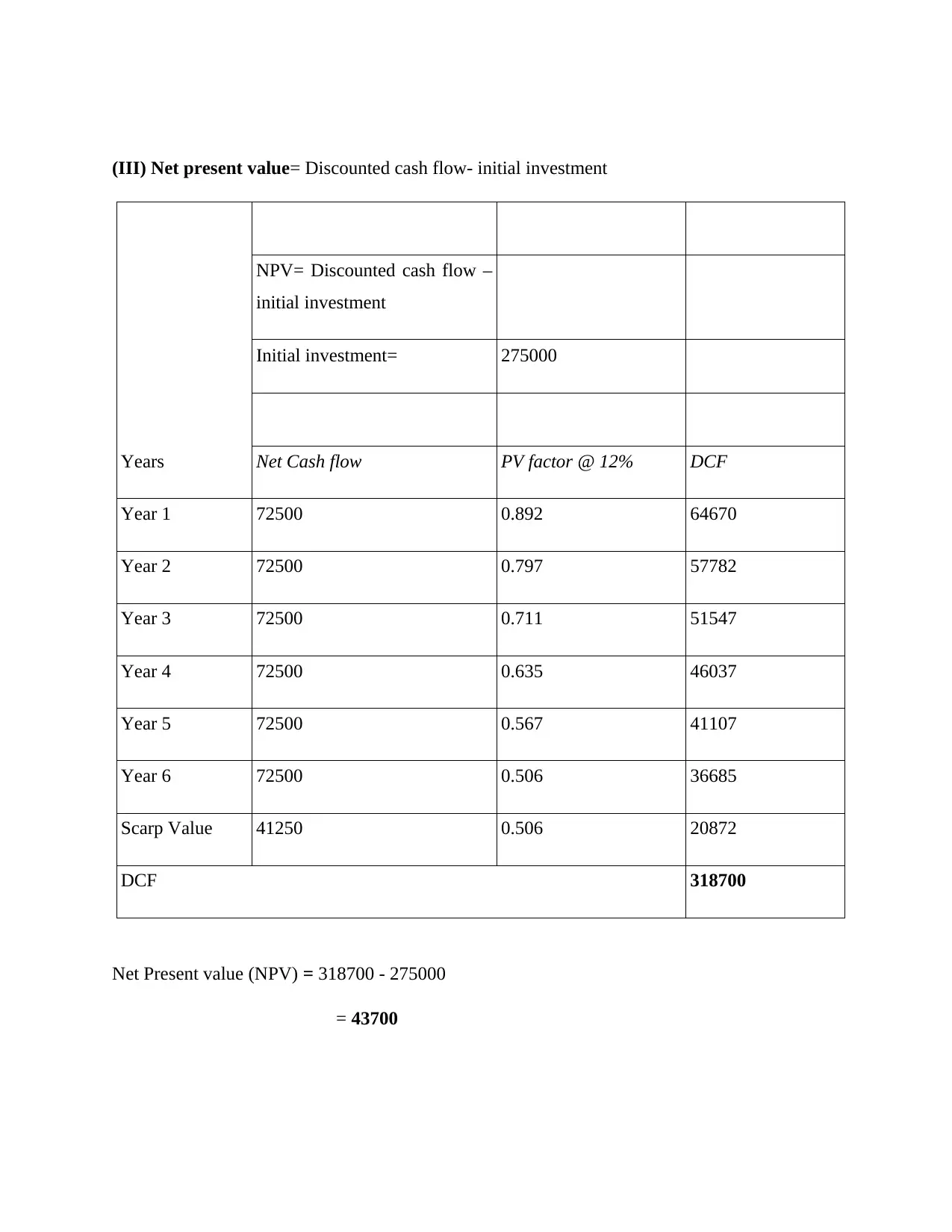
(III) Net present value= Discounted cash flow- initial investment
Years
NPV= Discounted cash flow –
initial investment
Initial investment= 275000
Net Cash flow PV factor @ 12% DCF
Year 1 72500 0.892 64670
Year 2 72500 0.797 57782
Year 3 72500 0.711 51547
Year 4 72500 0.635 46037
Year 5 72500 0.567 41107
Year 6 72500 0.506 36685
Scarp Value 41250 0.506 20872
DCF 318700
Net Present value (NPV) = 318700 - 275000
= 43700
Years
NPV= Discounted cash flow –
initial investment
Initial investment= 275000
Net Cash flow PV factor @ 12% DCF
Year 1 72500 0.892 64670
Year 2 72500 0.797 57782
Year 3 72500 0.711 51547
Year 4 72500 0.635 46037
Year 5 72500 0.567 41107
Year 6 72500 0.506 36685
Scarp Value 41250 0.506 20872
DCF 318700
Net Present value (NPV) = 318700 - 275000
= 43700
⊘ This is a preview!⊘
Do you want full access?
Subscribe today to unlock all pages.

Trusted by 1+ million students worldwide
1 out of 20
Related Documents
Your All-in-One AI-Powered Toolkit for Academic Success.
+13062052269
info@desklib.com
Available 24*7 on WhatsApp / Email
![[object Object]](/_next/static/media/star-bottom.7253800d.svg)
Unlock your academic potential
Copyright © 2020–2026 A2Z Services. All Rights Reserved. Developed and managed by ZUCOL.




